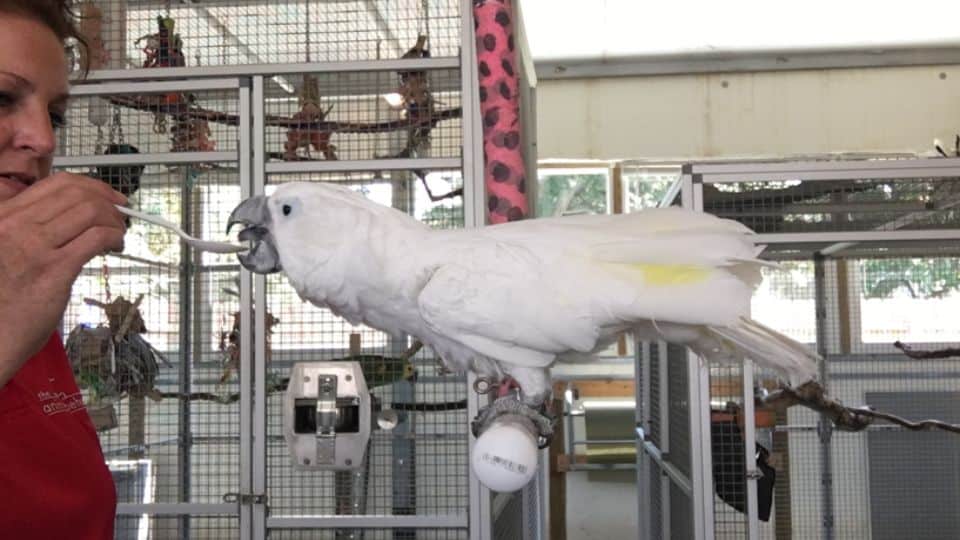
Resource guarding refers to a behavior where an animal exhibits protective or possessive actions over an item, a space they consider valuable, and even another animal. The objects or areas protected could include food, toys, treats, entrance to a certain room, or even a person or another animal. Resource guarding may be identified by the animal stiffening, an animal running toward and object, or a lunge or snap when something gets close to the guarded item or area. It is a common and natural behavior that I have seen in humans and many other animals including parrots, primates, and reptiles.
Let me give a few examples. Koko, our educational Umbrella cockatoo resource guards Rico, our other educational Umbrella cockatoo. If Koko sees a person or other bird go near Rico, Koko will begin screaming and pacing inside his enclosure while staring at the person or other bird getting near or interacting with Rico. This could be a dangerous situation for the person or other bird if Koko had access to them.
We are very aware of this situation and have developed a behavior modification plan that we keep in place to lessen the likelihood of this behavior. The behavior modification plan is important to prevent an accident and reduce Koko’s stress. We have witnessed this behavior over the past few years and it will likely be a behavior we have to keep on a management schedule, meaning it will likely never end, but we can keep it under control. We make sure everyone is aware of the behavior and what to do to prevent Koko’s resource guarding of Rico.
We’ve shaped the behavior of Koko remaining calm while we interact with Rico by reinforcing calm behavior from Koko as we approach Rico, interact with Rico, and move Rico. When we move Koko to other locations, such as coming out of his enclosure and onto his play gym, we take him closer to Rico and then move him to his play gym. We also do this when we move Koko from his play gym and back to his enclosure, because when Koko is on his play gym, he’s closer in proximity than when he is in his enclosure. This reinforces calm behavior from Koko and we know because his calm behavior continues to happen each time we move him.
All of my dogs show resource guarding behaviors over toys, treats, food, and me. Snow, my deaf and blind dog will snap and spin if Levi, my deaf bulldog greets me at the door when I get home from the Center. I’ve seen it and identified it so I put a behavior modification plan in place before the behavior can intensify.
I have shaped the behavior of Levi stationing on the couch when he sees me walk up the stairs to the front door of the house. I have visual cues he can see through the front door. Through the door, I cue the behavior for Levi to bark when he sees me. Snow is usually lying on the couch next to Levi. When Snow feels the vibrations from Levi’s bark, this cues Snow to know I am home. As I unlock the door, this gives Snow time to meet me at the front door while I interact with her and let her know I’m home. When I am done greeting Snow, I then cue Levi to come to me and I greet him. Problem solved; no more snapping and biting on Levi from Snow.
Resource guarding can happen for many reasons. In my line of work of training unreleasable wildlife, education ambassadors of exotics and exotics in shelters, I also see subtle signs of resource guarding in many species. As I mentioned before, resource guarding can be a natural behavior, but I also see it in animals with a history of lacking enrichment or appropriate enrichment. This makes sense if you think about it. If an animal has little or no appropriate enrichment, why wouldn’t they resource guard it when they get it? I’ve identified animals resource guarding a blanket or something in their enclosure that we could consider trash, like a ripped up piece of cardboard. What is of value is always identified by the individual animal, not us.
It is important to be careful with your approach and put a behavior modification in place.
Our mission is to have animals thrive under our care, not just survive. When we know better, we do better. When we take the time and educate ourselves, our animals will do better.
Leave a Reply